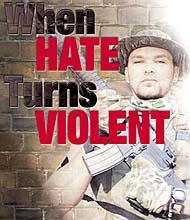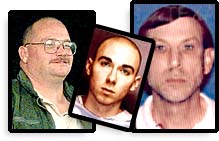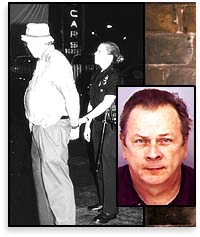
|


|
Preventing hate crimes depends on recognizing and identifying those who hate, and heading off violence before it occurs. An examination of religious hate activity illuminates the problem and solutions. |
by Richard Wieland

|
 |
Buford Furrow, Benjamin Smith and Larry Gene Ashbrook (from left to right) are among those who have turned hate into violence.
|
|

n an era that has seen hate violence reach hideous extremes, including the cold-blooded shooting of children in a Jewish community center and the murder of a postal worker because of his Asian heritage, the national discussion of hate crimes remains very much alive. The consensus is that the solution lies in prevention, and an escalating number of groups and websites devoted to curbing hate are springing up across the nation.
Yet while freedom of expression is an inviolable right, many question at what point hate-filled rhetoric turns from mere words into active incitement to violence, and how that violence can be predicted and thwarted.
As National Public Radio host Ray Suarez propounded on Talk of the Nation following one crime, “I mean, these people don’t send news releases out before they do the things they do. How can you be looking for the places where these crimes happen, the people that it happens to — be preventive in a way that’s different and distinct from normal crime fighting?”
Though the issues can be complex, one clear fact is that hate crimes have increased in the past decade. Incidents counted by the Federal Bureau of Investigation (FBI) nearly doubled between 1991 and 1998, the last year for which national statistics are available. Although the Violent Crime Control and Law Enforcement Act of 1994 tripled the penalty for “offenses the finder of fact at trial determines beyond a reasonable doubt are hate crimes,” the trend barely paused. The spotlight on prevention necessarily increased.
Failing to Act Early
The Hate Crimes Prevention Act (HCPA) was introduced in Congress in 1998, broadening interpretation of hate crimes and providing more power to federal officials to investigate and prosecute cases in which violence occurs as a result of bigotry.
The legislation, passed in the Senate in April 2000, has support from state and local government and law enforcement bodies and a broad range of national civil liberties organizations including the NAACP and the Jewish Anti-Defamation League, and individual supporters like the parents of Matthew Shepard, a homosexual student who died after being severely beaten and left tied to a fence post on the outskirts of Laramie, Wyoming.
Although laws offer the hope of curbing hate crime, the fact remains that law enforcement can only act after a crime has been committed.
Civil rights and religious groups across the country agree that more effective citizen action is needed to stop hate crimes before they happen. There are almost always people who were aware of hate-motivated incidents or circumstances that were preludes to violence. Too often, however, those who might prevent a tragedy choose not to get involved.
There are almost always people who were aware of hate-motivated incidents or circumstances that were preludes to violence.
|
|
Matthew Shepard’s brutal beating death was a case in point. “Wyoming has always reflected the epitome of the ‘Don’t ask, don’t tell’ attitude,” said a friend of Shepard. “This horrible murder has shattered our ability to hide behind that type of stance.”
In contrast, a number of groups have chosen to tackle head-on preludes to hate-instigated violence.
The Catholic League for Religious and Civil Rights contacts media outlets which air or publish material slanderous to Catholics, issues news releases to condemn bigoted
portrayals of Catholics, formally responds to educators or employers perceived to deny rights to Catholics in school or at work, and takes legal action where considered necessary. “When the religious freedom rights of any American are threatened,” states the League on its website, “the Catholic League stands ready to fight for justice in the courts.”
The Jewish Anti-Defamation League, the Council on American-Islamic Relations, the Southern Poverty Law Center and other religion-based and civil rights groups conduct similar activities and provide information, guidance and tips on websites and in publications designed to counter hate and to prevent it from proliferating into violence.

|
 |
Purveyors of religious hate, including Keith Henson (above, being handcuffed) and Robert Minton, have demonstrated some of the warning signs that lead to violent crime.
|
 |
The Fruits of Hate
Hate crime authorities widely acknowledge the importance of tracing hate campaigns to the individual bigots who incite them, which can enable such a campaign to be shut down at its source.
A number of the nation’s anti-religious extremists were once loosely organized under the umbrella of a hate group known as the Cult Awareness Network (CAN)*, which orchestrated a climate of bigotry in which violence could be fostered against selected religions. While the group known as CAN today promotes religious tolerance under new management, its predecessor targeted members of religious groups, primarily Christian, for “deprogramming” — forced conversions from faith which can include coercion, kidnapping, assault, battery and even rape.
Among those involved with the former CAN and its survivor sister organization, the so-called “American Family Foundation,” are members of the Skeptics movement, with its avowedly anti-religious ideology. Web sites of Skeptics have contained anti-Christian vernacular not unlike the virulent words on the website of Larry Gene Ashbrook who gunned down churchgoers, mostly teenagers, in a Baptist church in Texas in September 1999.
CAN collapsed in 1996 following a wave of arrests and convictions of deprogrammers and a $4.85 million damage award in a federal civil judgment in Washington State against the group, its executive director and several individuals for a violent deprogramming attempt on a young Christian man. The jury found the defendants’ activity to be “utterly intolerable in a civilized community.”
When the defendants tried to overturn the judgment, Federal Court Judge John Coughenour observed that each seemed to have an “incapability of appreciating the maliciousness of their conduct.”
Among the individuals found liable in the Washington case was Rick Ross, CAN’s highest profile deprogrammer. Ross matches the prototype of a dangerous bigot: described by his psychiatrist as a sociopath, he has run afoul of the law for much of his adult life. His record includes a conviction for grand theft after attempting to embezzle $100,000 in jewelry from a store in Phoenix, Arizona, preceding his career as a deprogrammer-for-hire. As early as 1976, a report by the Arizona Department of Health Services noted that Ross “cannot realize that what he does is socially unacceptable and dangerous... he does not seem to identify himself with society and its laws.”
Ross also had a history of run-ins with the law for deprogramming activity. Regardless, in 1993, he maneuvered himself into the role of an “advisor” to the U.S. Bureau of Alcohol, Tobacco and Firearms (ATF) and FBI prior to and during the lethal 1993 debacle with the Branch Davidian community and its leader, David Koresh, outside Waco, Texas. The mindset of CAN towards the Christian group was expressed in a statement of then CAN President Patricia Ryan in The Houston Chronicle on April 9, 1993, during the standoff which preceded the fiery deaths of nearly 80 men, women and children: “[O]fficials should use whatever means necessary to arrest Koresh, including lethal force.”
The rest is history. Law enforcement recognized the dangers of advice from those involved in the former CAN and began taking stock of the background of potential experts for consultation on matters of religion.
But although that incarnation of CAN soon died as an organization, the bigotry and hatred of its scattered members and kindred groups and allies did not.
continued...
|

|





